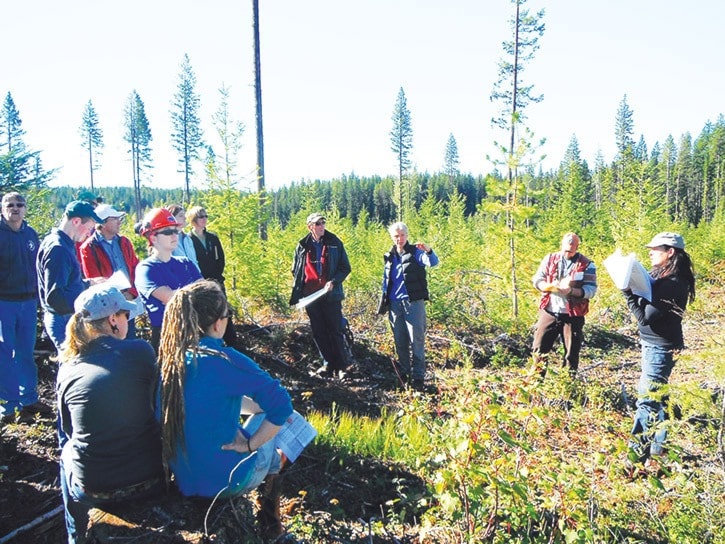Uniform shelterwood is a silviculture system that can be applied to meet a number of objectives.
Although called a silviculture system, it employs harvesting as the means to achieve its regeneration objectives.
In the Cariboo region the uniform shelterwood system has been demonstrated as a way of successfully regenerating Douglas-fir on frost prone sites east of Williams Lake.
It can also reduce silviculture costs, meet other land use objectives by retaining a stocked stand on the site, produce higher value logs and increase timber yield off the site.
The Cariboo Region is fortunate enough to have local expertise in the shelterwood system. In 1990, a shelterwood trial was initiated as a collaboration between UBC’s Alex Fraser Research Forest, West Fraser Mills Ltd. (Weldwood of Canada at the time), and the Ministry of Forests.
Three sites east of Williams Lake were examined in the study.
The most easily accessible one is near the start of the Gavin Lake Road. Researcher Michaela Waterhouse of the Ministry of Forests Lands and Natural Resource Operations, along with Ken Day of the UBC Research Forest have been involved with the trial since the beginning and are a wealth of information on the topic. West Fraser has had a number of foresters involved in the trial.
Most recently professional foresters Mauro Calabrese, Graham Fulton and Susan Woermke have been involved from West Fraser.
Mauro and Graham have worked on the implementation of the final harvest, and Susan on the regeneration of the sites.
Much has been learned from this trial both in terms of where and how to apply the shelterwood system from a silviculture perspective, as well as operational knowledge on implementing the system on a larger scale moving forward.
For example, it does not work well on wetter sites and is difficult to implement on steeper slopes.
The collaboration between researchers, licensee foresters and harvesting contractors proved to be a positive learning experience for all.
Each bought a different perspective and in the end a great result on the ground was achieved. Progressive Harvesting Ltd., and owner Tim Tugnum, were involved in the original preparatory cutting back in 1991, again in 2000, and for the final Harvest in 2011.
Initially it was thought that doing three lighter entries over a 20-year period would be best, but the trial showed that given the correct site conditions, doing two entries where approximately 50 per cent of the basal area (or volume) is removed at each entry over a 10- to 15-year period may be most beneficial.
There were also encouraging results when the growth rates of the stand were examined.
It was shown that even after removing up to half of the volume in the first cuts, the remaining trees were able to accumulate as much growth as a stand that was not harvested.
This means that additional volume was generated from the site compared to if it would have been clearcut harvested or not harvested at all.
This additional growth was all being added as high value, clear peeler wood.
These are encouraging results which could see the application of the shelterwood system to help alleviate mid-term timber supply issues.
The original goal of regenerating Douglas-fir on sites where it has been difficult to do so was realized.
In fact some of the treatments may have too much regeneration on them as they were left too long before the final cut was done.
Employing a silviculture system that leaves a stocked stand through the entire 10- to 15-year process is beneficial for other forest values such as visual quality, wildlife, and hydrology.
Numerous tours have been made to the trial sites and much has been learned from the trial.
A number of extension notes and publications authored by Ken Day, Michaela Waterhouse and others have been published detailing the results.
West Fraser is planning on moving to the operational application of the uniform shelterwood silviculture system in 2015, using the knowledge gained from the experience of the research trial.
